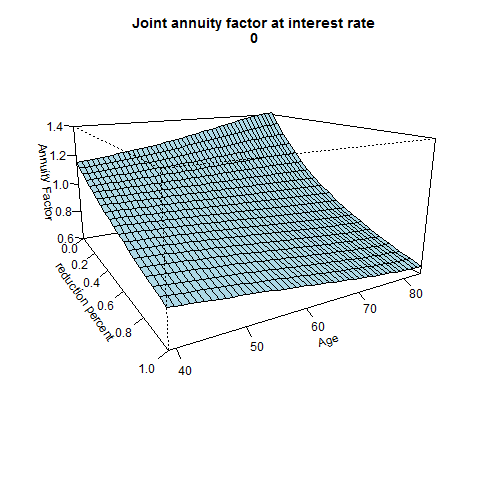At retirement from employment, it is common for pension plan participants to have earned a lifetime annuity in the amount of (PEN) per year whose expected present value is (PEN ddot{a}_x ). Suppose that the participant has a spouse (or other dependent) age (y) and wishes to purchase an annuity that continues to provide benefits even after (x) has died to the survivor (y). For example, a joint and 75% survivor annuity makes an annual payment of 1 while both (x) and (y) are alive, a payment of 0.75 while only one of (x) and (y) are alive, and no payments following the death of both (x) and (y). Thus, expected present value of this annuity is ( 0.75 (ddot{a}_x + ddot{a}_y) – 0.50 ddot{a}_{xy}). To equate these two values, we require the new pension amount (PEN_{JS}) to be that amount so that (PEN ddot{a}_x = PEN_{JS} left(0.75 times (ddot{a}_x + ddot{a}_y) – 0.50 ddot{a}_{xy} right)). More generally, define the annuity factor
begin{eqnarray*}
ANN~FACTOR = frac{ddot{a}_x}{RED (ddot{a}_x + ddot{a}_y) + (1-2RED) ddot{a}_{xy}},
end{eqnarray*}
for the reduction factor (RED).
The dynamic graph shows values of (ANN~FACTOR) plotted against the reduction factor (RED) and age, where for plotting purposes we use a common age (x=y). The graph shows the dynamic effect over interest rate (i) ranging from 0 to 20%. The graph shows that it is difficult to provide a general interpretation for the factor as a function of the reduction percentage and age. However, as the interest rate (i) increases, the factor approaches one for all values of the reduction percentage and age.
